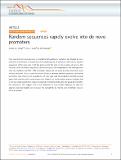| dc.contributor.author | Yona, Avihu H. | |
| dc.contributor.author | Alm, Eric J. | |
| dc.contributor.author | Gore, Jeff | |
| dc.contributor.author | Yona, Avihu | |
| dc.contributor.author | Alm, Eric J | |
| dc.date.accessioned | 2018-08-27T18:36:36Z | |
| dc.date.available | 2018-08-27T18:36:36Z | |
| dc.date.issued | 2018-04 | |
| dc.date.submitted | 2017-11 | |
| dc.identifier.issn | 2041-1723 | |
| dc.identifier.uri | http://hdl.handle.net/1721.1/117556 | |
| dc.description.abstract | How new functions arise de novo is a fundamental question in evolution. We studied de novo evolution of promoters in Escherichia coli by replacing the lac promoter with various random sequences of the same size (∼100 bp) and evolving the cells in the presence of lactose. We find that ∼60% of random sequences can evolve expression comparable to the wild-type with only one mutation, and that ∼10% of random sequences can serve as active promoters even without evolution. Such a short mutational distance between random sequences and active promoters may improve the evolvability, yet may also lead to accidental promoters inside genes that interfere with normal expression. Indeed, our bioinformatic analyses indicate that E. coli was under selection to reduce accidental promoters inside genes by avoiding promoter-like sequences. We suggest that a low threshold for functionality balanced by selection against undesired targets can increase the evolvability by making new beneficial features more accessible. | en_US |
| dc.publisher | Nature Publishing Group | en_US |
| dc.relation.isversionof | http://dx.doi.org/10.1038/S41467-018-04026-W | en_US |
| dc.rights | Creative Commons Attribution 4.0 International License | en_US |
| dc.rights.uri | http://creativecommons.org/licenses/by/4.0/ | en_US |
| dc.source | Nature | en_US |
| dc.title | Random sequences rapidly evolve into de novo promoters | en_US |
| dc.type | Article | en_US |
| dc.identifier.citation | Yona, Avihu H. et al. “Random Sequences Rapidly Evolve into de Novo Promoters.” Nature Communications 9, 1 (April 2018): 1530 © 2018 The Author(s) | en_US |
| dc.contributor.department | Massachusetts Institute of Technology. Department of Biological Engineering | en_US |
| dc.contributor.department | Massachusetts Institute of Technology. Department of Physics | en_US |
| dc.contributor.mitauthor | Yona, Avihu | |
| dc.contributor.mitauthor | Alm, Eric J | |
| dc.contributor.mitauthor | Gore, Jeff | |
| dc.relation.journal | Nature Communications | en_US |
| dc.eprint.version | Final published version | en_US |
| dc.type.uri | http://purl.org/eprint/type/JournalArticle | en_US |
| eprint.status | http://purl.org/eprint/status/PeerReviewed | en_US |
| dc.date.updated | 2018-08-23T14:41:57Z | |
| dspace.orderedauthors | Yona, Avihu H.; Alm, Eric J.; Gore, Jeff | en_US |
| dspace.embargo.terms | N | en_US |
| dc.identifier.orcid | https://orcid.org/0000-0001-8469-6735 | |
| dc.identifier.orcid | https://orcid.org/0000-0001-8294-9364 | |
| dc.identifier.orcid | https://orcid.org/0000-0003-4583-8555 | |
| mit.license | PUBLISHER_CC | en_US |
